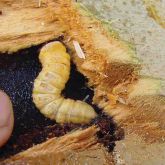Longicorn borers

Typical longicorn larva; note creamy white colour

Two-hole borer (Phoracantha solida) damage, showing 2 oval larval tunnels into heartwood

Ringbarking longicorn (P. mastersi) wounds on mature spotted gum

Bulls-eye borer (P. acanthocera) damage on rose gum, with oval shaped groove above central tunnel
Longicorn borers are also known as longicorn beetles. The larvae are sometimes known as round-headed borers.
In Australian subtropical hardwood plantations, attacks from 3 Phoracantha species contribute a significant proportion of the total damage. Although the borers are rarely seen, their presence can be established by the damage they cause to tree stems.
Scientific name
Other names
- Two-hole borer (P. solida)
- Ringbarking longicorn (P. mastersi)
- Bulls-eye borer (P. acanthocera)
Similar species
- P. solida is similar to both P. placenta and P. synonyma.
- P. mastersi can be confused with P. complicata.
- P. acanthocera is similar to P. princeps.
- Two other native Australian longicorn borers–the common eucalypt longicorn (P.semipunctata) and the yellow longicorn (P. recurva) are eucalypt pests in Queensland and many parts of the world.
Description
- Adults have narrow bodies, 22–48mm long.
- Antennae are as long as, or longer than, the body.
- Body colour varies from dark reddish brown to blackish brown or yellowish brown, with or without markings.
- Adults are active flyers but are not often observed, partly because they are nocturnal, hiding under loose bark or in crevices during the day.
- Larvae are cream, 20–40mm long, with a reddish head and chewing mouthparts.
- They live and pupate in the stems and branches of trees, so are also rarely seen.
- Fine frass (similar to sawdust) around the base of the tree is an early sign.
- Kino (blood-red sap) bleeding is also an early sign.
- See images of P. solida , P. mastersi and P. acanthocera adults on PaDIL.
.
Distribution
- Found in south-eastern and northern Queensland, mostly in coastal regions. They are also found throughout Australia.
Hosts
Longicorn borers are attracted to freshly cut wood, dying limbs, and trees suffering from stress, especially drought stress. They can attack living trees of all ages, but particularly target trees aged 6–20 years old and more than 5cm diameter at breast height (DBH). Preferred species include:
- spotted gums (Corymbia species)
- rough barked apple (Angophora floribunda)
- yellow stringybark (Eucalyptus acmenoides)
- Dunn's white gum (E. dunnii)
- rose gum (E. grandis) and hybrids
- grey gum (E. longirostrata, E. propinqua, E. punctata)
- tallowwood (E. microcospellita)
- large-fruited red mahogany (E. pellita)
- blackbutt (E. pilularis)
- red mahogany (E. resinifera)
- Sydney blue gum (E. saligna).
Damage
- The larvae feed on the phloem sap beneath the bark, creating large, damaged areas under the bark.
- They may bore into the heartwood several times before creating a pupal chamber there. When they hatch, the adults chew emergence holes through the bark. Wood quality and structure are affected.
- Larval tunnelling causes the production of kino veins and the detachment of bark from the tree. Where bark is breached, sapwood can be subjected to fungal staining and wood rot.
- There may only be 1 or a few larvae per tree; however, even a couple of larvae can kill a tree.
- Wounds generally seal as the tree grows.
Two-hole borer (P. solida):
- Larvae feed in the cambium over a roughly circular area of 20–30cm diameter
- Small air holes may be created through the bark
- Adult larvae bore into the heartwood to pupate. Falling bark at this stage exposes sapwood and 1 or 2 oval-shaped holes packed with frass.
Ringbarking longicorn (P. mastersi):
- Large wounds, associated with copious kino bleeding, are caused by larvae feeding under the bark.
- Larvae feed in groups, making galleries in a spiral pattern over a large area of the stem.
- Feeding that encircles saplings or small trees (girdling) can kill them.
- The affected area can turn grey-black.
Bulls-eye borer (P. acanthocera):
- There is a typical oval-shaped groove around a central hole or 'bulls-eye'.
- Borers are usually hidden beneath the bark, when only splits in the bark are visible. When the beetle emerges, the bark falls, revealing the damage.
- Extensive kino veins and pockets can be created in the timber.
Biology
- 1–50 eggs are laid in cracks or at the site of tree damage, typically in spring or during periods of maximum water stress for the tree.
- The life cycle takes around 2 years.
Control
- Various wasp species are parasites of longicorn borers; however these have not been developed as biocontrol agents.
- Conventional pesticides are not usually effective as the larvae are protected within the tree.
- Silvicultural management systems that enhance resistance by promoting tree vigour are important. Ensuring an adequate supply of potassium, iron and nitrogen in the soil may assist, as these nutrients have been found to be deficient where P. solida attacks were more frequent.
- Kiln drying of timber will kill all stages of the borers.
Resources and research
- Carnegie, A, Lawson, SA, Smith, T, Pegg, GS, Stone, C, McDonald, J 2008, Healthy hardwoods: a field guide to pests, diseases and nutritional disorders in subtropical hardwoods, Forest and Wood Products Australia, Victoria.
- Debuse, VJ, Smith, TE, Holloway, CT, Wiegand, AN, Nahrung, HF, Lawson, SA, 2019, Environmental influences on stem borer incidence in Australian subtropical Corymbia plantations, Journal of Pest Science, 92:579–593, viewed July 2023.
- Peters, BC, King, J, Wylie, FR, 1996, Pests of timber in Queensland, Queensland Forestry Research Institute, Brisbane.
- Wang, Q, 1995, A taxonomic revision of the Australian genus Phoracantha Newman (Coleoptera: Cerambycidae), Invertebrate Taxonomy, 9(5):865–958, viewed July 2023.
- Pests and diseases image library (PaDIL)